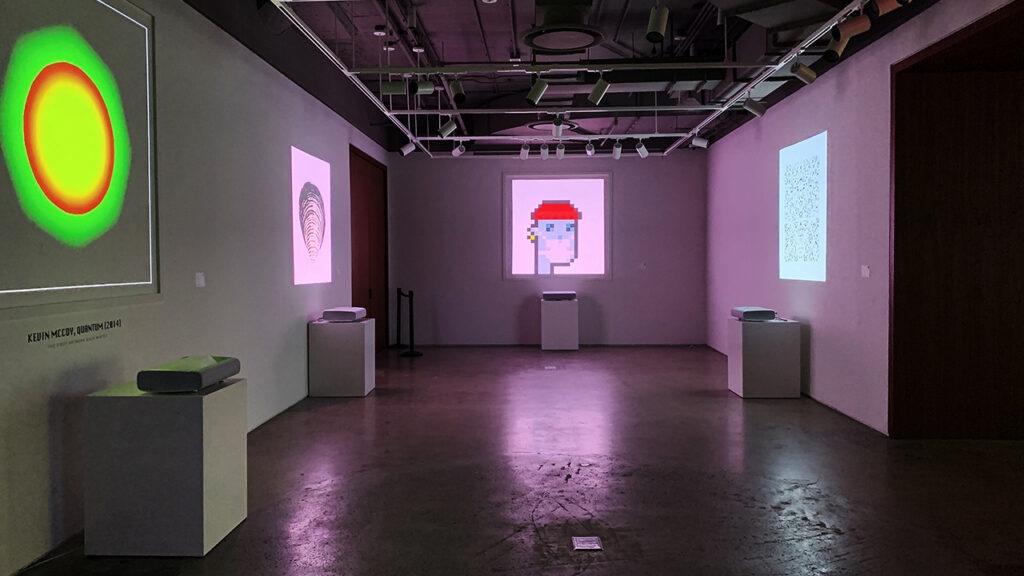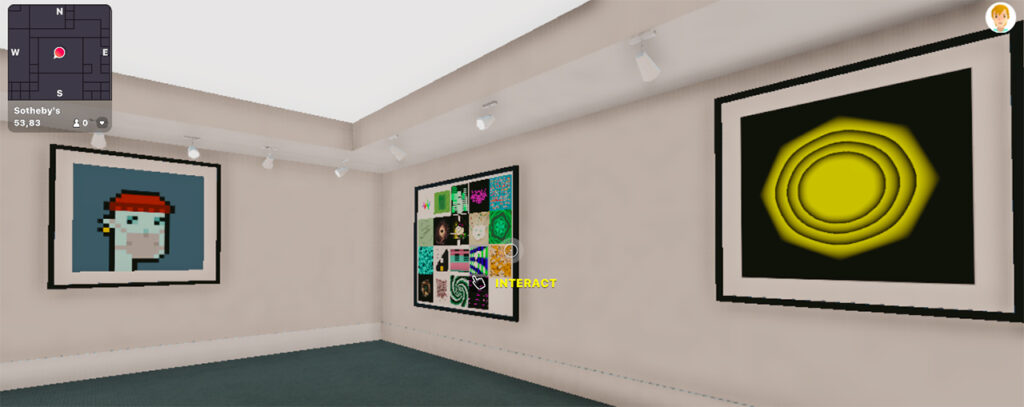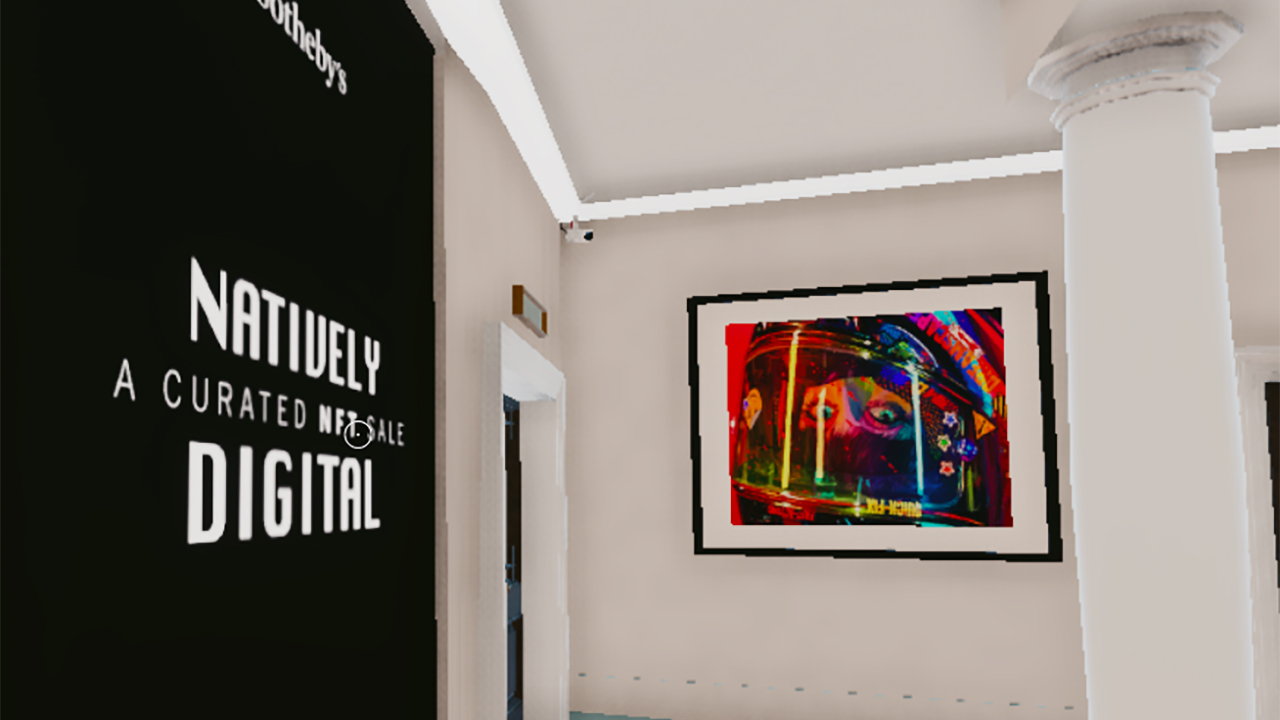People like firsts. Ever since NFTs shrouded the art world in a speculative, energy consumptive haze, the globe’s leading auction houses have been trading firsts like some frenzied tennis match in which the prize is a slightly larger chunk of the metaverse.
Christie’s served with Beeple in March, the first NFT offered by a major auction house, Sotheby’s returned a month later with the first sale of influential crypto artist Pak, Christie’s then dropped the first CryptoPunks auction, and now Sotheby’s has smashed out double firsts: the first auction house to stage a physical exhibition of NFTs and — here’s the winner — sell the first-ever NFT, Kevin McCoy’s “Quantum,” minted in 2014.
Natively Digital differs from its auction predecessors. For starters, there’s the physicality of the thing: buyers are invited to Sotheby’s spaces in New York, London, or Hong Kong to visit and experience crypto art beyond 13-inch screens and web browsers. This is courtesy of Samsung’s Frame TVs and 4K projectors, spectacular in detail and vivid in color — 100 percent color volume to use industry parlance — and designed, as Sotheby’s puts it, “to look like real art.” For those more inclined to the metaverse, Sotheby’s has replicated its New Bond Street galleries inside the Voltaire Art District of virtual social platform Decentraland complete with its London commissionaire stationed outside to greet visitors.


Natively Digital at Sotheby’s New York (above) and on Decentraland (below), featuring “CryptoPunk 7523” and “Autoglyph #177” by Larva Labs, and “Quantum” by Kevin McCoy. Images: Min Chen and Richard Whiddington
Then there’s the work itself. Previous auctions have largely focused on single creators, leaving the task of curating for high-calibre collectors to selective NFT marketplaces such as SuperRare and Foundation. Sotheby’s worked alongside longtime crypto artist Robert Alice, whose Portraits of Mind, a series of giant disc paintings riddled with bitcoin source code, drew early attention to crypto art when at Christie’s way back in 2020.
Together, Sotheby’s and Alice present a frenetic and global snapshot of an art category that was non-existent less than a decade ago. This includes classic “early” creations, such as one of nine alien CryptoPunks, a host of works glowing with dystopian cyberpunk aesthetics, and probing, speculative ones that question blockchains and NFTs themselves.
“For Natively Digital, we took a historical approach and curated a selection of works that present the scope of NFTs spanning the seven-year history of the medium,” Michael Bouhanna, Sotheby’s Contemporary Art Specialist, tells Jing Culture & Commerce. “We wanted to make sure we look forward to the incredible work being done today that touches on the possibilities of the medium.”

“Robert Alice x Alethea AI,” an iNFT. Image: Sotheby’s
This future-facing spirit was most notably on display in two works: “Autoglyph #177”, a Larva Labs work owned by Flamingo Dao, a Decentralized Autonomous Organization (DAO), whose members share resources and vote in decisions executed by smart contracts; and “Robert Alice x Alethea AI” an intelligent NFT (iNFT) — the world’s first, says Sotheby’s — in which an individual can converse with a “self-learning” AI. Though in this writer’s experience, Alethea greeted each approach with a blank expression and downward glance as if busy texting.
For all the newness and the blitz of shiny neon aesthetics that five years ago belonged firmly in the realm of video games and animation, Natively Digital is far from divorced from non-digital traditions. There’s a reimagining of Claude Monet’s “Meules” by Matt Kane, an Afro-Futurism play on Michaelangelo’s “Creation of Adam” by Serwah Attafuah, and a photograph turned NFT by American artist Justin Aversano.
But will Sotheby’s curation efforts and the ability to visit a physical exhibition convince more traditional art collectors to buy in? Bouhanna thinks so: “We’ve already seen strong interest and now that NFTs have gained widespread attention and recognition, with proven results at every level of the market and proven staying power, more and more traditional art collectors have expressed interest in NFTs.”
Even so, reluctance from more establishment collectors may not be an issue; throughout the string of auction house firsts unveiled on the art market in 2021, one constant has been the acceptance of cryptocurrency — proof that the NFT community is well catered to.



